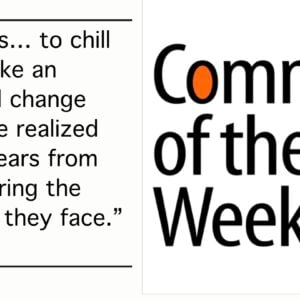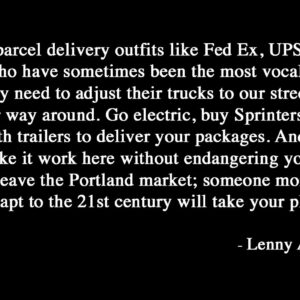“Great cities require vibrant urban spaces that are human scaled, and car storage is antithetical to that goal.”
— Andrew

Welcome to the Comment of the Week, where we highlight good comments in order to inspire more of them. You can help us choose our next one by replying with “comment of the week” to any comment you think deserves recognition.
In four bracing paragraphs written in response to our story last week on EV parking at multi-unit dwellings, reader Andrew delivers a primer on how to create a vibrant city. Clip this comment and put it in your wallet for those times when you are feeling inarticulate (you can just pull it out and read it to whomever you need to — if you agree with what Andrew is saying).
The comment had several characteristics we look for: it was on-topic with the article, it used a personal situation to make a point, and it pulled in some facts about our area.
Here’s what Andrew wrote:
Advertisement
You are operating with the implicit assumption that people will have a car. Reducing parking capacity is a net positive, since it incentivizes people to live with fewer cars. Demand for off-street and on-street parking isn’t a reason to justify more supply – great cities require vibrant urban spaces that are human scaled, and car storage is antithetical to that goal.
And frankly, on-street parking is one of the biggest wastes of public space imaginable. Dedicating half the right of way for free vehicle storage is just mind-numbingly bad land use. Imagine if 15% of the on-street parking capacity in Portland was dedicated to bikes or public transportation (15% of Multnomah county residents do not own a personal vehicle).
If a renter wants an EV now, they almost literally have no options for charging anyways… so having no parking vs. status quo parking with no chargers is hardly different. Developers use parking (including EV chargers) as perks/services that they provide to renters for a cost. My apartment’s lot costs 125$/month to park in – presumably if they added EV chargers, they would charge a premium for that as well.
And there already is basically no incentive for anyone to build affordable housing – because there never will be. Developers don’t want to deal with the hassle that comes with affordable housing anyways. The best way to solve a housing crisis is with public housing – that is what the US did in the post WWII era, there is no reason we can’t do it now.
You can read Andrew’s comment and the full comment thread on the original post.
Thank you Andrew, we appreciate you being part of the conversation.






Thanks for reading.
BikePortland has served this community with independent community journalism since 2005. We rely on subscriptions from readers like you to survive. Your financial support is vital in keeping this valuable resource alive and well.
Please subscribe today to strengthen and expand our work.
I strongly agree. And I would add that those who argue that we can address our housing crisis by building more “class A” apartments (essentially the only multi-unit housing being built) or a few more “small houses” are functioning as apologists for a market failure that created an ongoing chronic housing crisis centered on low income people. The market is the primary cause of our housing crisis and further deregulation/subsidy of our highly financialized housing market is certain to only further increase housing inequity (and asset speculation).
What about the Low Income Housing Tax Credit program? How about Section 8, both project based and vouchers?
Is there any concern at all about the per unit costs relative to the private market of the government owned housing we do have?
I believe this all gets back to the foundational question, is it the responsibility of all residents of a place to provide housing for anyone who wants to live in that place?
I don’t think this is the foundational question, actually, because it’s already a given. I’d posit that the more relevant question is: What do we prefer the public “housing” we already provide one way or the other to be: Actual housing, pavement for tents/RVs in travel corridors, or prison?
These all cost residents, one way or another.
I’d love to see a visual mockup of just what Soren’s optimal city would look like.
Hear hear, a most deserving CotW.
I think we need to have more discussions about where (“free”) markets do not produce efficient allocation of resources and work to erode this near religious devotion to them. They seem to do particularly poorly where societal need is concerned, such as with housing, healthcare, transportation, or public space (just to name a couple). Sneakers, toothpaste, soda, and TVs? Sure, markets all the way.
This is all to say: I fully concur with this, especially the last paragraph.
There is no “free market” in housing, healthcare, transportation, or public space in the Metro area:
Housing is highly regulated. First land is not available, unless Metro says so, and the government mandated UGB severely limits the supply, driving up the cost. Permits for a home in WA CO used to be $30K several years ago – not sure what they are today. Most building products are also highly regulated.
In Health Insurance, only one type of plan is legal in the USA: ACA compliant plans. Because of this, premiums are exorbitant, as are the deductibles. Because ACA has no limit on payout, doctors can charge anything they want because insurance will pay it (after your $8K deductible). It’s the worst of all worlds as Mr. Gruber said was the intent.
On transportation, ALL transportation infrastructure is run by the city, state, metro.
On public space – it is all done by government – there is no free market in “public space”.
No, we do not need public housing:
https://halbaronproject.web.illinois.edu/items/show/45
The government is not going to protect you – see Uvalde, TX for a recent example – police sitting for an hour before acting.
Here’s another example of how government fails to protect you. Similar cases to this one are happening every day in Oregon:
https://www.youtube.com/watch?v=jszrt4Bw8yw
A man warned us of this a few decades ago:
https://www.youtube.com/watch?v=xhYJS80MgYA
I used to spend lots of time several years ago researching old photos of downtown at the Oregon Historical Society. The contrast between what used to be downtown and what replaced it was depressing. Every parking lot downtown used to be a 2-6 story building. The sidewalks (and often streets themselves) used to have throngs of people, with active businesses on the ground floors. Recent development has replaced many of the parking lots, but parked cars and driveways still dominate downtown’s streets.
The Vintage Portland blog is often kinda depressing. You realize our physical spaces throughout Portland used to be so much more people-oriented and energized like we always want them to be today.
Through the late half 20th century we essentially sacked this city for automobile accessibility and ‘civic improvement’. Today we have just fragments of what it once was.
Most US cities had much wider sidewalks downtown before 1930 than they do today; however most sidewalks outside of downtown were put in during the 1930s as federally-funded WPA make-work projects, including in Portland.
That’s not even remotely true. Walk around just about any streetcar-era neighborhood in ne or se portland and you can see the name of the company who built the sidewalk, and the year it was built, stamped right into the concrete.
PBOT report from 2000: https://bikeportland.org/2021/08/16/follow-up-digging-a-bit-deeper-on-portland-sidewalk-history-336621
Sigma many/most, streetcar lines were built pre-depression. That photo of the sidewalk stamp in the article David links to is from the 1920s, in an area developed along a streetcar line. Those houses got indoor plumbing, sewage/stormwater pipes and, yes, the concrete sidewalks that the stormwater pipes enabled. I assume the developer put in the sidewalk. WPA sidewalks have a WPA stamp, I’m pretty sure.
The Goose Hollow Sewage Project is currently replacing all those 100 year old pipes, and in doing so the trucks damaged some of the corners. So that old sidewalk stamp is gone, and new concrete has been poured. I’m glad I got a photo of it.
Roundabout way of saying that both you and David are right. But the WPA is not the city.
He had me right up until the final paragraph! I don’t know enough to provide a citation-heavy rebuttal, but I disagree with some of the claims about “affordable housing.” First, there are lots of developers building affordable housing in Portland. The city has created literal “incentives” to increase the construction of affordable housing, and developers have responded predictably by planning and building affordable housing.
I think we can all agree that the local government’s response to the housing crisis has yet to yield measurably cheaper housing, or a decrease in homelessness. But if you look at the scale of the region’s outlays for “affordable housing,” the amounts are sizable! So I’d also challenge the notion that the sole solution is public housing. In fact, given the cost per square foot of local public housing built to date, the idea that the city could purchase sufficient land and construct sufficient numbers of units to end the housing crisis is clearly not reasonable.
The scale of the problem is such that some private market rate housing development must be necessary to bring current prices down. The city hadn’t managed to build enough temporary housing for 3,000-4,000 homeless people in the years since this crisis began. I think it’s very unlikely the city could manage to permanently house the hundreds of thousands more residents who would benefit from more affordable housing!